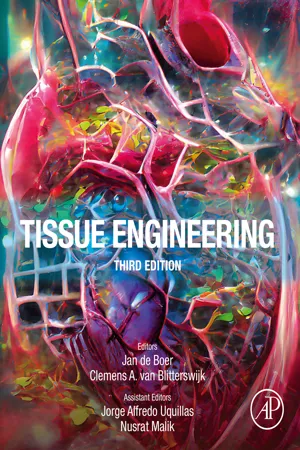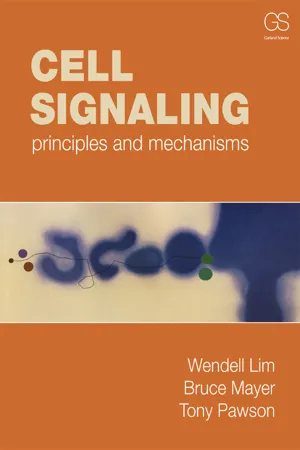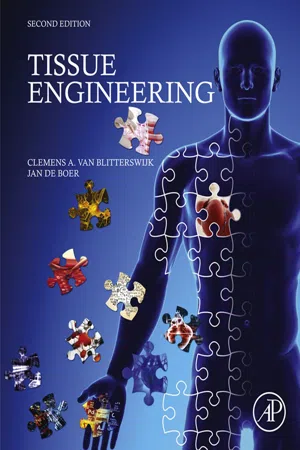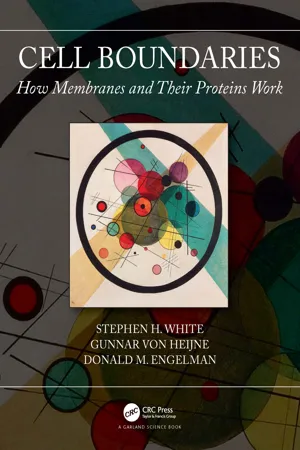Biological Sciences
Juxtacrine Signaling
Juxtacrine signaling is a form of cell communication in which a signaling molecule on one cell membrane binds to a receptor on an adjacent cell, transmitting a signal directly between the two cells. This type of signaling is important for coordinating cellular activities, such as during development and immune responses, and is distinct from other forms of cell signaling, such as paracrine and endocrine signaling.
Written by Perlego with AI-assistance
Related key terms
Related key terms
1 of 4
Related key terms
1 of 3
10 Key excerpts on "Juxtacrine Signaling"
- eBook - ePub
- Marc J. Klowden(Author)
- 2013(Publication Date)
- Academic Press(Publisher)
Juxtacrine Signaling , this is the fastest mode of communication and can be found in cardiac muscle cells whose contractions are coordinated, allowing these to occur simultaneously. Contact-dependent signaling also occurs during early development, giving adjacent cells information about their location relative to other cells, and can specify their developmental fate.Neuronal signaling delivers messages across long distances within the organism to specific cells. As described in Chapter 11 , a signaling neuron sends an electrical signal along its axon that triggers the release of a neurotransmitter at its synapse with a target cell (Figure 1.3C ). The neurotransmitter binds to postsynaptic receptors in target cells, causing a physiological response in those cells. The speed of transmission is rapid, but depends on the physical distance over which the signal must travel.Paracrine and endocrine signaling both involve the diffusion of signal molecules through an extracellular medium. Endocrine signaling is the most public, releasing hormones into the blood that are distributed to all cells of the body (Figure 1.3D ). Only those cells with receptors that recognize the hormone are capable of responding. The signaling cells may consist of endocrine cells or more specialized neurosecretory cells. Some endocrine signaling molecules are hydrophobic and are able to cross the cell membrane and bind to internal receptor proteins, but most others are peptides that must remain outside and bind to external receptors.Paracrine signaling is more intimate, with the signal molecules diffusing not through the blood but through the extracellular matrix instead (Figure 1.3E ). The proteins secreted by the target cells are effective over only a short distance and induce changes only in neighboring cells that bear specific receptors localized in regions of cytoplasmic extensions called cytonemes - eBook - ePub
- Marc J. Klowden, Subba Reddy Palli(Authors)
- 2022(Publication Date)
- Academic Press(Publisher)
Fig. 1.3A ). An example is the prothoracic gland, which during some developmental stages activates its own production of ecdysteroids.Fig. 1.3 Types of cell signaling. (A) Autocrine signaling. (B) Contact-dependent signaling. (C) Neuronal signaling. (D) Endocrine signaling. (E) Paracrine signaling. See the text for an explanation.Contact-dependent signaling relies on direct contact between neighboring cells, with signaling molecules embedded in the cell membranes or passed directly through pores (Fig. 1.3B ). The signaling cell may produce a molecule that binds to a receptor in the adjacent target cell or release ions that are transferred through gap junctions to trigger a response only in those cells that are in direct contact. Also called Juxtacrine Signaling, this is the fastest mode of communication and can be found in cardiac muscle cells whose contractions are coordinated, allowing these to occur simultaneously. Contact-dependent signaling also occurs during early development, which gives adjacent cells information about their location relative to other cells and can specify their developmental fate.Neuronal signaling delivers messages across long distances within the organism to specific cells. As described in Chapter 11 , a signaling neuron sends an electrical signal along its axon that triggers the release of a neurotransmitter at its synapse with a target cell (Fig. 1.3C ). The neurotransmitter binds to postsynaptic receptors in target cells, causing a physiological response in those cells. The speed of transmission is rapid but depends on the physical distance that the signal must travel.Paracrine and endocrine signaling both involve the diffusion of signal molecules through an extracellular medium. Endocrine signaling is the most public, releasing hormones into the blood that are distributed to all cells of the body (Fig. 1.3D - No longer available |Learn more
- Mary Wuerth(Author)
- 2023(Publication Date)
- Barrons Educational Services(Publisher)
UNIT 4Cell Communication and Cell CyclePassage contains an image
10
Cell Communication and Signaling
Learning ObjectivesIn this chapter, you will learn:➜Types of Cell Signaling➜Signal Transduction➜Disruptions in Signal Transduction Pathways➜Feedback MechanismsOverview
Biological systems interact, exchange information about their environments, and respond to this information. Life often depends on responding quickly to changing environmental conditions. This chapter reviews the basics of cell communication and the process of signal transduction.Types of Cell Signaling
The survival of a living organism depends on the ability of its cell, or cells, to communicate by sending, receiving, and responding to chemical signals. These chemical signals are called ligands. Figures 10.1–10.4 show four general types of cell signaling:1.Autocrine signaling—In autocrine signaling, the cell secretes a ligand. This ligand then binds to a receptor on the cell that secreted the ligand, triggering a response within that same cell. The root word auto means “self,” so this process can be thought of as a cell signaling itself to generate a response. An example of this is a cancer cell, which releases its own growth hormones (the ligands) that stimulate the cancer cell to grow and divide.Figure 10.1 Autocrine Signaling2.Juxtacrine Signaling—This is signaling that depends on direct contact between the cell that is sending the ligand and the cell that is receiving and responding to it via a surface receptor. Examples of Juxtacrine Signaling include plasmodesmata in plants (which involve the ligand traveling between channels that connect adjacent cells) and antigen-presenting cells in the human immune system (which signal helper T cells through direct cell-to-cell contact).Figure 10.2 Juxtacrine Signaling3.Paracrine signaling - Timir Tripathi, Vikash Kumar Dubey, Timir Tripathi, Vikash Kumar Dubey(Authors)
- 2022(Publication Date)
- Academic Press(Publisher)
143.2: Signaling via cell–cell direct contact or Juxtacrine Signaling
Cellular communication also occurs through direct cell-to-cell contact where both the receptor and ligand are membrane-bound. It is also known as Juxtacrine Signaling and can occur through three mechanisms: cell-to-cell direct contact, gap junction-mediated signaling, and extracellular matrix (ECM)-mediated signaling. One of the most important examples of Juxtacrine Signaling is the notch-delta signaling pathway. Notch signaling is involved in stem cell fate maintenance and also cell differentiation by the lateral inhibition mechanism.15 Signaling involving the ECM-mediated crosstalk between integrins and actin cytoskeleton controls a wide array of vital cellular functions such as proliferation, migration, apoptosis, and differentiation.164: Cell signaling orchestrates key biological processes
Cells need to be in constant communication with neighboring cells and the extracellular environment to maintain internal homeostasis, grow, and divide. Signal transduction helps the cells internalize the external cues and carry out effector functions necessary for survival. Signaling controls virtually all the key biological processes of cells, i.e., cell growth, division, differentiation, energy metabolism, migration, and cell death. A signal transduction pathway can regulate one or more of these cellular functions. There are various modes of cell-to-cell communication, depending on the source of the signal received by the cells. Cells can receive messages carried by small molecules, peptides, or proteins secreted by other cells. Cells can also undergo direct physical contact with each other for signaling. They can also receive signals from the extracellular matrix (ECM), where the ECM relays information through mechanical stimuli or ECM-bound molecules. Physical factors, such as heat, light, electrical impulses, and mechanical forces, also activate specific signaling pathways. All these signals activate specific pathways that translate into a change in cell behavior and function. The various modes of signaling and the associated pathways are discussed in the next section.- eBook - ePub
Volatile Biomarkers for Human Health
From Nature to Artificial Senses
- Hossam Haick, Hossam Haick(Authors)
- 2022(Publication Date)
- Royal Society of Chemistry(Publisher)
Part 2: Communication: Volatile Biomarkers as a Signaling AgentsPassage contains an image Chapter 9 Signal Transfer and Transduction between Cells
Mamatha Serasanambatia , Dina Hashoul,b and Hossam Haick,ba a Department of Medicine, Washington University in St. Louis, St. Louis, MO 63110, USA;b Department of Chemical Engineering and Russell Berrie Nanotechnology Institute, Technion – Israel Institute of Technology, Haifa 3200003, IsraelEmail: [email protected]9.1 Introduction
Cell-to-cell communication has a critical role during tumor development and progression, allowing cancer cells to reprogram the surrounding tumor microenvironment and cells located at distant sites.1 ,2Cells communicate by several means, nonetheless, with broadly three types of cell communication: autocrine, paracrine and Juxtacrine Signaling.3 In autocrine signaling, a cell secretes a chemical messenger and has the cognate receptor, thereby allowing it to communicate with itself and other cells of the same type. Paracrine signaling involves at least two types of cells: one cell type without the cognate receptor secretes a chemical message, whereas another cell type has the cognate receptor but does not secrete the biomolecule. Lastly, Juxtacrine Signaling involves two cells in which one cell has a membrane-bound ligand that binds to its cognate receptor on another cell.2 –5Proteomic and genomic approaches have been the main approaches to study signaling communication in cell proliferation, migration, cell recognition and differentiation.6 Though tremendous advances have been achieved, several limitations restrict the fulfilment of approaches to diagnosis and therapeutic applications. These limitations include but are not confined to:5 –9(1) proteomics and genomics requiring prior and accurate knowledge of specific genes or proteins, exclusive to in vitro and in vivo trials – something that does not necessarily reflect real-life situations; and (2) genomics and proteomics, which continue to be expensive and of low specificity and which require complex analytical algorithms that are prolonged and cumbersome. Since cancer is a systematic disease (polygenetic) that involves several mutations at different sites8 (genetic, epigenetic, local to or at a distance from the primary tumor, etc. - eBook - ePub
- Clemens van Blitterswijk, Jan De Boer(Authors)
- 2022(Publication Date)
- Academic Press(Publisher)
And finally, not all signaling begins with a ligand–receptor interaction. Of particular relevance to tissue engineering, cell signaling can also be initiated by physical cues, such as the elasticity of the substrate upon which a cell resides (see Chapter 5 Extracellular matrix as a bioscaffold for tissue engineering and Chapter 6 Synthetic Biomaterials). Nonetheless, our present understanding is detailed enough to be applicable by tissue engineers aiming to direct cell behavior, and many studies have shown that mimicking the ligand–receptor interactions that exist in native tissue can improve the behavior of cells in a tissue-engineered construct. Figure 4.1 (a) Cell signaling leads to changes in the responding cell. (b) Although many variations on this theme exist, signaling events often adhere to this paradigm. A central paradigm can be recognized in most events of cellular signaling, consisting of three distinct steps (Fig. 4.1B): I. Signal initiation: An extracellular ligand binds to a receptor on the surface of the cell. Ligand binding changes the activity or conformation of the receptor, thus transducing the signal to the inside of the cell. II. Signal transduction: The activated receptor triggers a signal transduction cascade in which intracellular proteins are activated, ultimately leading to activation of a transcription factor in the nucleus. III. Gene activation: The transcription factor binds to regulatory sequences in target genes, resulting in gene activation, protein synthesis, and changed cellular physiology. In the following section, some main types of signals, receptors, and the machinery for gene activation are described. Examples from specific tissues and tissue engineering are given, but it is important to note that many of these pathways are involved in multiple cell types. 4.3 - eBook - ePub
- Wendell Lim, Bruce Mayer, Tony Pawson(Authors)
- 2014(Publication Date)
- Garland Science(Publisher)
1 Introduction to Cell SignalingAll living cells perceive signals from the outside environment and adjust their behavior accordingly. If you think back to the earliest living cells, it is easy to imagine the incredible pressure they were under to evolve the ability to sense features of the environment and to change in response to these signals. The ability to sense and move toward nutrients, or to sense and avoid stresses and toxins, would give a unicellular organism a huge competitive advantage. This ability to respond to environmental cues is important for single cells, but it is also absolutely essential for the normal development and functioning of multicellular organisms, which depend on a continuous and extensive exchange of information to coordinate the activities of many individual cells. Furthermore, when this cellular communication goes awry, it can result in diseases such as cancer. In this chapter, we will introduce the basic principles of cell signaling and the molecular mechanisms that underlie it.What Is Cell Signaling?
Cells are the smallest fundamental units of life. Part of what makes them so distinctly “living” is their remarkable ability to sense stimuli and to respond to them in a dynamic manner. This ability of cells to detect or receive information and process it to make decisions can also be considered from the broader perspective of information processing. Here we can draw analogies to the engineering and design principles of other, more familiar information-processing systems, such as human- made electronic devices. It is this interface between the unique properties of living systems and the more universal properties of any system that processes information that makes the study of cellular signaling mechanisms so compelling. - eBook - ePub
- Clemens van Blitterswijk, Jan De Boer(Authors)
- 2014(Publication Date)
- Academic Press(Publisher)
A fundamental lesson to take from this chapter is that cell signaling is astonishingly complex. For instance, since the gene and protein expression profile are different for every cell type, cells will respond differently to certain signals. Examples abound, just one of which is the cellular response to the glucocorticoid hormones, which trigger cell death in lymphocytes, but stimulate osteogenic differentiation in mesenchymal stem cells. Furthermore, cells respond differently to ligands at different concentrations and different rates of change. They also respond differently depending on other aspects of their environment and their individual history. To add to this complexity, cells in the body are not exposed to a single signal at a single concentration, but to a cocktail of hormones, cytokines, and growth factors. And finally, not all signaling begins with a ligand–receptor interaction. Of particular relevance to tissue engineering, cell signaling can also be initiated by physical cues, such as the elasticity of the substrate upon which a cell resides.That being said, a central paradigm can be recognized in most events of cellular signaling, consisting of three distinct steps (Figure 4.1(b) ):1. Signal initiation: An extracellular ligand binds to a receptor on the surface of the cell. Ligand binding changes the activity or conformation of the receptor, thus transducing the signal to the inside of the cell.3. Gene activation: The transcription factor binds to regulatory sequences in target genes, resulting in gene activation, protein synthesis, and changed cellular physiology. In the following section, the main types of signals, receptors, and the machinery for gene activation are described.2. Signal transduction: The activated receptor triggers a signal transduction cascade in which intracellular proteins are activated, ultimately leading to activation of a transcription factor in the nucleus.4.1.2. Signal Initiation
The first step in this paradigm of cell signaling is the interaction of a ligand with its receptor. A wide variety of molecules in the body serve as ligands and these can be incorporated in regenerative medicine strategies to influence cell behavior. Irrespective of their identity, most ligands share the characteristic that they physically interact with their ligand, which is usually a transmembrane protein that binds with the signal molecule in the extracellular space and transduces the signal into the cell. This is certainly the case for hydrophilic ligands or molecules that cannot pass through the plasma membrane, but some small or hydrophobic molecules can diffuse through the membrane and bind targets in the cytosol or the nucleus. - Available until 4 Sep |Learn more
- Angus O. McKinnon, Edward L. Squires, Wendy E. Vaala, Dickson D. Varner, Angus O. McKinnon, Edward L. Squires, Wendy E. Vaala, Dickson D. Varner, Angus O. McKinnon, Edward L. Squires, Wendy E. Vaala, Dickson D. Varner(Authors)
- 2011(Publication Date)
- Wiley-Blackwell(Publisher)
Paracrine : the target cell is physically close to the hormone-releasing cell. The hormone acts locally by diffusing from its source to target cells in the neighborhood. Examples: histamine, neurotransmitters, and neurohormones.- Autocrine : the hormone acts on the same secretory cell that produced it. Examples: growth factors, cytokines.
- Neuroendocrine : cells acting in this manner provide a linkage between the nervous and endocrine systems. Hormones are released into the circulation in response to a neural stimulus. Example: epinephrine release from the chromaffin cells of the adrenal medulla.
- Juxtacrine : intercellular communication requires physical contact between cells, with transmission via oligosaccharide, lipid, or protein components of the cell membrane. Adjacent cells must possess broad patches of closely opposed plasma membrane linked by transmembrane channels known as connexons. Examples: growth factors, cytokine and chemokine cellular signals.
- Intracrine : refers to the action of the hormone, in this case being intracellular, being directed towards the cell of origin following retention or occurring after internalization. Examples: some peptide hormones and growth factors.
- Exocrine : the hormone or secretory product is directed outwards via a duct system. Examples: within the reproductive system the prostate and mammary glands. Outside the reproductive system many examples exist, including the exocrine pancreas, sweat glands, and salivary glands.
Some hormones can be classified as working in more than one of the above fashions. Example: testosterone has both paracrine actions (stimulates spermatogenesis in local seminiferous tubules) and endocrine actions (secondary sexual characteristics and muscle deposition).A pulsatile pattern of secretion is seen for virtually all hormones, with variations in pulse characteristics that reflect specific physiological states. In addition to the short-term pulses, longer-term temporal oscillations or endocrine rhythms are also commonly observed and are undoubtedly important in both normal and pathological states. - eBook - ePub
Cell Boundaries
How Membranes and Their Proteins Work
- Stephen White, Gunnar von Heijne, Donald Engelman(Authors)
- 2021(Publication Date)
- Garland Science(Publisher)
15 Information Transfer: Signaling in Cells DOI: 10.1201/9780429341328-16 All cells in an organism have the same genome, yet they develop into different organs and become specialized for different functions during development. Even single-cell organisms must be able to react to changes in their environment. How can cells react to what goes on in their surroundings? How are they triggered by extracellular or intracellular signaling molecules to activate intracellular regulatory circuits that move them down specific developmental pathways or guide their migration? In short, how can information be transferred from the outside of the cell to its inside? In both single-cell and multicellular organisms, information transfer in most cases involves transmembrane (TM) receptors located at the cell surface (Figure 15.1). The classical view is that binding of an extracellular ligand traps the receptor in an “active” state—a conformation that allows intracellular effector proteins to bind to cytosolic parts of the receptor and to be activated in turn. The activated effector proteins then diffuse into the cell, triggering cellular responses such as the opening of ion channels or activation of gene transcription. Certain small signaling molecules do not need receptors on the cell surface but can diffuse across the cell membrane into the cell and trigger soluble nuclear receptors that bind directly to DNA. Still other signals arise from the cytoplasm and interact directly with cytoplasmic domains of kinases. Figure 15.1 A few of the signal transduction pathways in eukaryotes. The pathways are numerous and complex, and interact with one another
Index pages curate the most relevant extracts from our library of academic textbooks. They’ve been created using an in-house natural language model (NLM), each adding context and meaning to key research topics.
Explore more topic indexes
Explore more topic indexes
1 of 6
Explore more topic indexes
1 of 4









